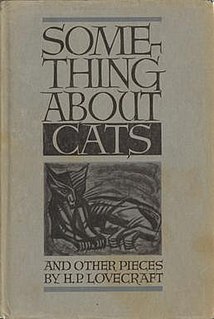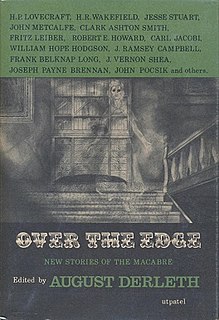
August William Derleth was an American writer and anthologist. Though best remembered as the first book publisher of the writings of H. P. Lovecraft, and for his own contributions to the Cthulhu Mythos and the cosmic horror genre, as well as his founding of the publisher Arkham House, Derleth was a leading American regional writer of his day, as well as prolific in several other genres, including historical fiction, poetry, detective fiction, science fiction, and biography.
Arkham House is an American publishing house specializing in weird fiction. It was founded in Sauk City, Wisconsin, in 1939 by August Derleth and Donald Wandrei to publish hardcover collections of H. P. Lovecraft's best works, which had previously been published only in pulp magazines. The company's name is derived from Lovecraft's fictional New England city, Arkham, Massachusetts. Arkham House editions are noted for the quality of their printing and binding. The colophon for Arkham House was designed by Frank Utpatel.

Weird fiction is a subgenre of speculative fiction originating in the late 19th and early 20th centuries. Weird fiction either eschews or radically reinterprets ghosts, vampires, werewolves, and other traditional antagonists of supernatural horror fiction. Writers on the subject of weird fiction, such as China Miéville, sometimes use "the tentacle" to represent this type of writing. The tentacle is a limb-type absent from most of the monsters of European folklore and gothic fiction, but often attached to the monstrous creatures created by weird fiction writers, such as William Hope Hodgson, M. R. James, and H. P. Lovecraft. Weird fiction often attempts to inspire awe as well as fear in response to its fictional creations, causing commentators like Miéville to paraphrase Goethe in saying that weird fiction evokes a sense of the numinous. Although "weird fiction" has been chiefly used as a historical description for works through the 1930s, it experienced a resurgence in the 1980s and 1990s, under the labels of New Weird and Slipstream, which continues into the 21st century.

Donald Albert Wandrei was an American science fiction, fantasy and weird fiction writer, poet and editor. He was the older brother of science fiction writer and artist Howard Wandrei. He had fourteen stories in Weird Tales, another sixteen in Astounding Stories, plus a few in other magazines including Esquire. Wandrei was the co-founder of the prestigious fantasy/horror publishing house Arkham House.

Marginalia is a collection of Fantasy, Horror and Science fiction short stories, essays, biography and poetry by and about the American author H. P. Lovecraft. It was released in 1944 and was the third collection of Lovecraft's work published by Arkham House. 2,035 copies were printed.

Something About Cats and Other Pieces is a collection of fantasy, horror and science fiction short stories, poetry and essays by American author H. P. Lovecraft. It was released in 1949 and was the fourth collection of Lovecraft's work published by Arkham House.

The Arkham Sampler was an American fantasy and horror fiction magazine first published in Winter 1948. The headquarters was in Sauk City, Wisconsin. The magazine, edited by August Derleth, was the first of two magazines published by Arkham House. It was published on a quarterly basis. The cover design was prepared by Ronald Clyne and was printed in alternating colors for the eight quarterly issues. Each issue had a print run of 1,200 copies with the exception of the Winter 1949 "All Science-Fiction Issue", of which 2,000 copies were printed. The Autumn 1949 issue was the last edition of the magazine.

The Shuttered Room and Other Pieces is an anthology of fantasy and horror short stories, essays and memoirs by American author H. P. Lovecraft and others. It was released in 1959 by Arkham House in an edition of 2,527 copies and was the fifth collection of Lovecraft's work to be released by Arkham House. August Derleth, the owner of Arkham House, and an admirer and literary executor to Lovecraft, edited the collection and wrote the title story, "The Shuttered Room", as well as another story, "The Fisherman of Falcon Point" from lines of story ideas left by Lovecraft after his death. Derleth billed himself as a "posthumous collaborator".

Dark Mind, Dark Heart is an anthology of horror stories edited by American writer August Derleth. It was released in 1962 by Arkham House in an edition of 2,493 copies. The anthology was conceived as a collection of new stories by old Arkham House authors. The anthology is also notable for including the first Cthulhu Mythos story by Ramsey Campbell.

Over the Edge is an anthology of horror stories edited by American writer August Derleth. It was released in 1964 by Arkham House in an edition of 2,520 copies. The anthology was produced to mark the 25th anniversary of Arkham House. None of the stories had been previously published.

Travellers by Night is an anthology of horror stories edited by American writer August Derleth. It was released in 1967 by Arkham House in an edition of 2,486 copies. None of the stories had been previously published.

Dark Things is an anthology of horror stories edited by American writer August Derleth. It was released in 1971 by Arkham House in an edition of 3,051 copies. It was Derleth's fourth anthology of previously unpublished stories released by Arkham House. A translation in Japanese has also been released.

Lovecraft Remembered is a collection of memoirs about American writer H. P. Lovecraft, edited by Peter Cannon. It was released in 1998 by Arkham House in an edition of 3,579 copies. Nearly all the memoirs from previous Arkham publications of Lovecraft miscellany are included.
Peter Ruber was a United States author, editor and publisher. He had been an advertising executive, book publisher and, for the past two decades, a consultant and free-lance journalist for many leading business information technology magazines. He lived on Long Island, New York with his wife, three sons, three grandchildren and a mountain of books and literary papers.

The Night Side is an anthology of fantasy and horror stories edited by American writer August Derleth and illustrated by Lee Brown Coye. It was first published by Rinehart & Company in 1947. The stories had originally appeared in the magazines Amazing Stories, Collier's Weekly, Weird Tales, Saturday Review, The London Mercury, Unknown, Astounding Stories, Esquire, The Briarcliff Quarterly, Cosmopolitan, Blue Book, Top-Notch and Fantastic Adventures or in the collections The Clock Strikes Twelve, The Children of the Pool, Fearful Pleasures, Nights of the Round Table and My Grimmest Nightmare.

Sleep No More is an anthology of fantasy and horror stories edited by August Derleth and illustrated by Lee Brown Coye, the first of three similar books in the 1940s. It was first published by Rinehart & Company in 1944. Featuring short stories by H. P. Lovecraft, Robert E. Howard, Clark Ashton Smith and other noted authors of the macabre genre, many of the stories made their initial appearance in Weird Tales magazine. The anthology is considered to be a classic of the genre, and is the initial foray by Coye into the field of horror illustration.

The Sleeping and the Dead is an anthology of fantasy and horror stories edited by American writet August Derleth. It was first published by Pellegrini & Cudahy in 1947. Many of the stories had originally appeared in the magazines The London Mercury, Weird Tales, Scribner's, Dublin University Magazine, Unknown, Esquire, The Bellman, Vanity Fair and Black Mask. An abridged edition was published by Four Square Books in 1963 under the same title.

Strange Ports of Call is an anthology of science fiction stories edited by American writer August Derleth. It was first published by Pellegrini & Cudahy in 1948. The stories had originally appeared in the magazines Blue Book, Amazing Stories, Weird Tales, Science and Invention, Astounding Stories, Coronet, The New Review, The Black Cat, Thrilling Wonder Stories, Wonder Stories, Comet, The Saturday Evening Post, Collier's Weekly and Planet Stories.

When Evil Wakes is an anthology of fantasy and horror stories edited by American writer August Derleth. It was first published by Souvenir in 1963.

Weird Tales was a series of paperback anthologies, a revival of the classic fantasy and horror magazine of the same title, published by Zebra Books from 1980 to 1983 under the editorship of Lin Carter. It was issued more or less annually, though the first two volumes were issued simultaneously and there was a year’s gap between the third and fourth. It was preceded and succeeded by versions of the title in standard magazine form.


















